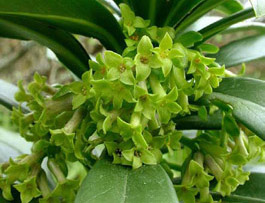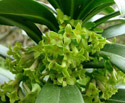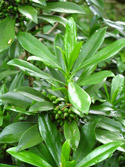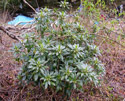Spurge Laurel
| Description: |
Spurge Laurel is a small bushy plant between 2 to 4 feet high, with leathery, shiny, evergreen leaves. Small, very fragrant yellow-green flowers bloom at the base of the leaves in late winter or early spring, followed by black, seed producing berries. The mature bark is gray with a yellow hue. |
||||
| Why Is it a Noxious Plant? |
All parts of the Spurge Laurel plant are highly toxic, including berries, leaves, stem, bark and sap. Due to the irritating toxins in the plant use extreme caution when cutting this plant. Gloves and other protective gear should be used when handling this plant. Keep the berries away from children and pets. It contains toxins which are poisonous to humans, as well as to dogs and cats. The sap can cause contact dermatitis, eye irritation, and digestive irritation if consumed. |
||||
| Where Does it Grow? |
S.L. will grow in sun or shade, and is healthiest with some of both. It is found most frequently in the forest understory. |
||||
| Facts: |
Spurge laurel is rapidly spreading in the Pacific Northwest. It poses a threat to native ecosystems, including Douglas fir forests and Garry oak woodlands. The shrub can produce dense patches that block sunlight and compete with native plants for water and nutrients. |
||||
| Control Options: |
Caution must be used when controlling spurge laurel by hand. The caustic sap from this plant can cause severe skin and eye irritation. Always wear protective clothing, gloves and eye protection and never transport this plant or cut plant materials inside an enclosed vehicle because the caustic compounds can cause respiratory irritation.
|
||||
| More Information: |
Download our Flyer or visit Washington State Noxious Weed Control Board Here. Photo by Leo Michels
|
||||
| More Pictures: |
|



